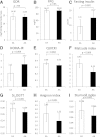Limitations in the use of indices using glucose and insulin levels to predict insulin sensitivity: impact of race and gender and superiority of the indices derived from oral glucose tolerance test in African Americans
- PMID: 23223406
- PMCID: PMC3609485
- DOI: 10.2337/dc12-0840
Limitations in the use of indices using glucose and insulin levels to predict insulin sensitivity: impact of race and gender and superiority of the indices derived from oral glucose tolerance test in African Americans
Abstract
OBJECTIVE To examine the utility of commonly used insulin sensitivity indices in nondiabetic European Americans (EAs) and African Americans (AAs). RESEARCH DESIGN AND METHODS Two-hundred forty nondiabetic participants were studied. Euglycemic-hyperinsulinemic clamp was the gold standard approach to assess glucose disposal rates (GDR) normalized by lean body mass. The homeostatic model assessment for insulin resistance (HOMA-IR) and the quantitative insulin sensitivity check index (QUICKI) were calculated from fasting plasma glucose and insulin (FIL). Oral glucose tolerance test (OGTT) was performed to determine Matsuda index, the simple index assessing insulin sensitivity (SI(is)OGTT), Avignon index, and Stomvoll index. Relationships among these indices with GDR were analyzed by multiple regression. RESULTS GDR values were similar in EA and AA subgroups; even so, AA exhibited higher FIL and were insulin-resistant compared with EA, as assessed by HOMA-IR, QUICKI, Matsuda index, SI(is)OGTT, Avignon index, and Stumvoll index. In the overall study population, GDR was significantly correlated with all studied insulin sensitivity indices (/r/ = 0.381-0.513); however, these indices were not superior to FIL in predicting GDR. Race and gender affected the strength of this relationship. In AA males, FIL and HOMA-IR were not correlated with GDR. In contrast, Matsuda index and SI(is)OGTT were significantly correlated with GDR in AA males, and Matsuda index was superior to HOMA-IR and QUICKI in AAs overall. CONCLUSIONS Insulin sensitivity indices based on glucose and insulin levels should be used cautiously as measures of peripheral insulin sensitivity when comparing mixed gender and mixed race populations. Matsuda index and SI(is)OGTT are reliable in studies that include AA males.
Figures


Similar articles
-
Myths and methodologies: Assessing glycaemic control and associated regulatory mechanisms in human physiology research.Exp Physiol. 2024 Sep;109(9):1461-1477. doi: 10.1113/EP091433. Epub 2024 Jul 16. Exp Physiol. 2024. PMID: 39014995 Free PMC article. Review.
-
Comparison of insulin sensitivity measures in South Asians.Metabolism. 2013 Oct;62(10):1448-54. doi: 10.1016/j.metabol.2013.05.016. Epub 2013 Jul 29. Metabolism. 2013. PMID: 23906497 Free PMC article.
-
Indices of insulin action, disposal, and secretion derived from fasting samples and clamps in normal glucose-tolerant black and white children.Diabetes Care. 2002 Nov;25(11):2081-7. doi: 10.2337/diacare.25.11.2081. Diabetes Care. 2002. PMID: 12401760
-
Correlation of oral glucose tolerance test-derived estimates of insulin sensitivity with insulin clamp measurements in an African-American cohort.Metabolism. 2004 Sep;53(9):1107-12. doi: 10.1016/j.metabol.2004.04.004. Metabolism. 2004. PMID: 15334368
-
The undervalued league of insulin resistance testing: uncovering their importance.Horm Mol Biol Clin Investig. 2024 Aug 8. doi: 10.1515/hmbci-2023-0061. Online ahead of print. Horm Mol Biol Clin Investig. 2024. PMID: 39113244 Review.
Cited by
-
Myths and methodologies: Assessing glycaemic control and associated regulatory mechanisms in human physiology research.Exp Physiol. 2024 Sep;109(9):1461-1477. doi: 10.1113/EP091433. Epub 2024 Jul 16. Exp Physiol. 2024. PMID: 39014995 Free PMC article. Review.
-
The effects of probiotics supplements on metabolic indices and clinical signs in patients with diabetic retinopathy, a randomized double blind clinical trial.J Diabetes Metab Disord. 2024 Apr 18;23(1):1133-1140. doi: 10.1007/s40200-024-01399-2. eCollection 2024 Jun. J Diabetes Metab Disord. 2024. PMID: 38932908
-
Decreased cardiovascular risk factors and inflammation with remission of type 2 diabetes in adults with obesity using a high protein diet: Randomized control trial.Obes Pillars. 2022 Dec 1;4:100047. doi: 10.1016/j.obpill.2022.100047. eCollection 2022 Dec. Obes Pillars. 2022. PMID: 37990670 Free PMC article.
-
Sex-Specific Comparison Between Triglyceride Glucose Index and Modified Triglyceride Glucose Indices to Predict New-Onset Hypertension in Middle-Aged and Older Adults.J Am Heart Assoc. 2023 Sep 19;12(18):e030022. doi: 10.1161/JAHA.123.030022. Epub 2023 Sep 18. J Am Heart Assoc. 2023. PMID: 37721166 Free PMC article.
-
Methods for estimating insulin resistance from untargeted metabolomics data.Metabolomics. 2023 Aug 9;19(8):72. doi: 10.1007/s11306-023-02035-5. Metabolomics. 2023. PMID: 37558891 Free PMC article.
References
-
- Reaven GM. Insulin resistance: the link between obesity and cardiovascular disease. Med Clin North Am 2011;95:875–892 - PubMed
-
- DeFronzo RA, Tobin JD, Andres R. Glucose clamp technique: a method for quantifying insulin secretion and resistance. Am J Physiol 1979;237:E214–E223 - PubMed
-
- American Diabetes Association Consensus Development Conference on Insulin Resistance. 5-6 November 1997. Diabetes Care 1998;21:310–314 - PubMed
-
- Matthews DR, Hosker JP, Rudenski AS, Naylor BA, Treacher DF, Turner RC. Homeostasis model assessment: insulin resistance and beta-cell function from fasting plasma glucose and insulin concentrations in man. Diabetologia 1985;28:412–419 - PubMed
-
- Katz A, Nambi SS, Mather K, et al. Quantitative insulin sensitivity check index: a simple, accurate method for assessing insulin sensitivity in humans. J Clin Endocrinol Metab 2000;85:2402–2410 - PubMed
Publication types
MeSH terms
Substances
Grants and funding
LinkOut - more resources
Full Text Sources
Medical

